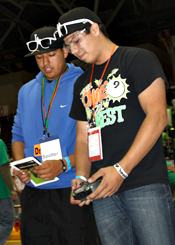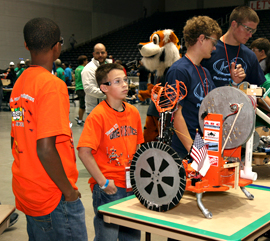A handful of students from Moody High School in Corpus Christi gathered around a table in an expansive indoor arena making final adjustments to a robot they dubbed “Chaos.”
Wearing matching black T-shirts and white sunglasses, they glanced occasionally at their notes on strategies to maximize their points in the final stage of the Texas BEST Regional Robotics Championship.
Theirs was one of more than 50 robots built by middle school and high school students competing in the championship hosted by UT Dallas over the weekend.
The contest marked the final stage of competition in the Texas BEST program this year, and more than 3,000 students and spectators attended the event.

Team members from Moody High School’s Innovation Academy pilot their robotic creation.
The Moody team traveled nearly 10 hours from the Texas coast to Dallas, where they showcased weeks of hard work and tinkering.
“I’ve always been interested in taking things apart and putting them back together,” said Raymond Salgado, a high school senior at Moody’s Innovation Academy for Engineering, Marine and Environmental Science. “We all had a part in building this robot.”
This was the first year the team made it to this stage of the contest, a feat that took them by surprise.
“At the semi-finals, we started taking our robot apart because we didn’t think we had enough points to win,” Salgado said. “But then they announced our name, so this is really awesome for us.”
Whatever anxiety the Moody High School team had before arriving, they said, vanished as they plunged into a dimly lighted tunnel entrance and emerged onto the arena floor to pumping music and pounding cheers from the audience gathered to watch contest.
“We’re ready to go,” said Rudy Medina, Jr., another Moody team member.

The contest marked the final stage of competition in the Texas BEST program this year. More than 3,000 students and spectators attended the event.
Each team collaborated on design, programming, and decorations for their machines, and all had to win their way to a coveted spot at the championship— 55 teams in all from Texas and New Mexico.
“Each year they have a different theme for the contest, and this year’s theme was ‘Bugs.’ Each of the teams had to build a robot that retrieved these so-called bugs and put them in a containment area,” said Dr. Kenneth Berry, assistant director of the UT Dallas Science and Engineering Education Center (SEEC). “We are extremely pleased and honored to have hosted this event. It’s exciting to see this kind of enthusiasm for robotics.”
The University’s Erik Jonsson School of Engineering and Computer Science was also a co-sponsor.
Each of the team’s robots had to maneuver through several obstacles with the help of a human driver who controlled its movements with a joy stick. The robots, some with artistic flairs and innovative designs, had to grab the bugs and place them in a corner of the playing field along with bug food.
Teams racked up points for each round depending on how many bugs and how much food their robots could obtain.
On the arena floor, referees in black and white striped shirts blew whistles, nervous family members and teachers watched the contests unfold, and several teams brought members of their schools’ marching bands and cheerleading teams. The theatrics created a pep-rally atmosphere at the Special Events Center at Garland.
Graham Gadd, a science teacher at Ereckson Middle School in Allen, has accompanied his team to the championship seven of the last eight years. He says the school’s success begins with intense enthusiasm for the robotics program that begins at the top and permeates to the students. “Getting them interested then giving them the opportunity to design the automation, artwork and all of the other components is so rewarding,” he said. “You have to be enthusiastic, and they just love it.”
The contest is one of three regional competitions sponsored by BEST, which stands for Boosting Engineering Science & Technology. Its mission is engaging and exciting students and inspiring them to pursue careers in those fields.
“This kind of project-based learning is incredibly important as a tool to get students interested in science and technology careers,” Berry said. “They learn so much about problem solving and working collaboratively. These students have to take a box of stuff and they get six weeks to make something out of it. It’s a true team effort and ultimately, it’s very fulfilling for teachers and students.”